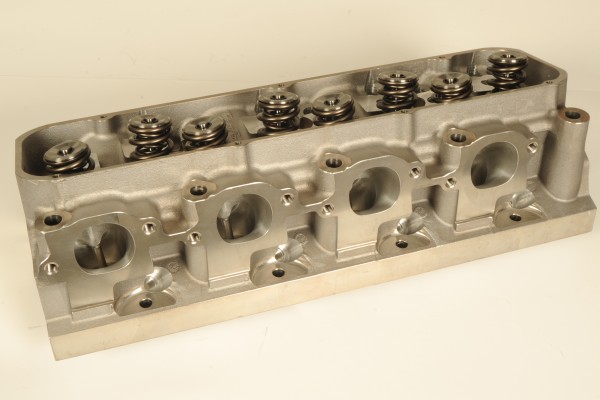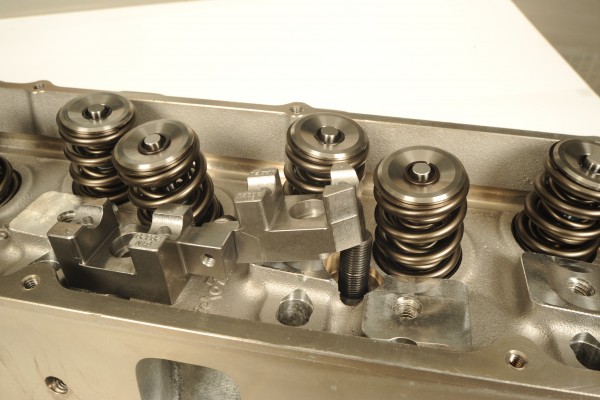In our initial Big Ford Horsepower post, we told you how Trick Flow Specialties in Akron, OH was building a 598 big block Ford to out-power the 1,013-horse 565 cubic-inch Chevy it had assembled the prior year. In that initial post, we covered the short block assembly and showed you how most of the parts were off the shelf, meaning virtually anyone can duplicate the build with parts from suppliers like Summit Racing Equipment.
With the foundation for the 598 big block Ford prepared, it’s time to install the top end of the engine—cylinder heads, valvetrain, and intake manifold—so all those cubic inches get all the air they need to make big horsepower. We’ll also show you a couple of modifications needed to get everything to play nice together.
The Cylinder Heads
The PowerPort A460 360 cylinder head is designed for engines with a minimum bore of 4.500 inches (stock is 4.3600 inches). This is a great head for high-compression, normally aspirated engines like our 598, or for engines with a power adder like a multi-stage nitrous system or a big Roots-style supercharger.
The PowerPort 360s feature:
• CNC-profiled 87cc combustion chambers with 2.400 inch intake/1.880 inch exhaust valves
• 360cc intake/180cc exhaust runners with Trick Flow’s CNC Competition Port job. This is Trick Flow’s top-of-the-line port work with a high-resolution surface finish for maximum airflow. The ports are raised for better airflow
• Trick Flow Track Max® Pacaloy™1.645 inch diameter triple valve springs, rated to handle up to .850 inches of valve lift
As tested on Trick Flow’s Superflow bench, peak airflow is 453 cfm intake/321 cfm exhaust at .800 inches of valve lift. But it’s the mid-lift figures that really show how good the PowerPort 360 is—369 cfm intake at .500 inches of lift and 410 cfm at .600 inches.
The Other Parts
Jesel Pro-Series Shaft Rocker Arms: Designed specifically for the PowerPort A460 cylinder heads, the 1.8 ratio Pro Series rockers are made from Jesel’s 7000 Series aluminum alloy. That allows Jesel to make a rocker arm that’s stronger, lighter, and more than 19 percent stiffer than a comparable Jesel Sportsman rocker.
Crane Ultra-Pro Mechanical Roller Lifters: Among the strongest roller lifters available, the Ultra-Pros are also very lightweight to reduce valvetrain weight and increase rpm potential. The lifters have a “four-column” design to improve torsional rigidity, reinforced pushrod seats, and micro-polished roller wheels.
Trick Flow Chromoly Pushrods: Made from 4130 chromoly steel, these one-piece pushrods are heat-treated for use with guideplates. Trick Flow closes off the tips, then drills and chamfers the oiling holes to .093 inch. That prevents stress fractures and cracks.
Trick Flow R-Series A460 Intake Manifold: Intended for 500-plus inch, high-rpm engines, the Trick Flow® R-Series A460 single plane intake manifold features a one-piece, spider-type design with high-flow, individual extended runners and a raised plenum floor. It’s designed for use exclusively with the PowerPort A460 cylinder heads.
Moroso Drag Race Oil Pan: This nine-quart pan is designed for tube-chassis cars including dragsters, roadsters, and doorslammers. The fabricated steel pan has a full-length sump and comes with a solid-louvered windage tray. It clears cranks up to 4.75 inch stroke (with aluminum rods). Trick Flow modified the pan for use with an external oil pump.
Next Time
In the next and final installment of our 598 Ford build, we’ll be fabricating a front motor plate and installing the Holley Dominator carburetor, MSD distributor, and front accessories (oil pump, crank trigger, balancer, and water pump). Then for the funnest part of all—strapping the engine on Trick Flow’s dyno and seeing how much power we can extract.
Parts List
Trick Flow PowerPort A460 360 Cylinder Heads
Trick Flow 18-Bolt Conversion Kit for PowerPort heads
Trick Flow MLS Head Gasket, each (2 required)
Crane Ultra-Pro Roller Lifters
Trick Flow Pushrods, 9.200 inch (intake)
Trick Flow Pushrods, 9.600 inch (exhaust)
Trick Flow R-Series A460 Intake Manifold
Trick Flow Intake Manifold Gaskets
Trick Flow Intake Manifold Bolt Kit
Trick Flow Cast Aluminum Valve Covers






















REALLY INTERESTING IF YOU WOULD LIKE TO A BUILD OF YOUR OWN.
sorry, I will be looking for next time–I enjoy what y’all do.
I want to hear it run–er crank up–where the hell is that?
Great stuff
Thomas, ask and you shall receive! We’ll have dyno video and sound posted next week.
Hello, I have a 24ft. welded aluminium river jet boat with a 460 in it. Yes it is a fuel pig! But not really that much worse than other inboard jets. The engine is rated at 320 horse. My thoughts are to build a 460 balanced with roller cam etc. I’m not sure if my thinking is right but if I built it with port EFI and build it to somewhere between 4 and 500 hp I would have an engine that wouldn’t have to work very hard to turn the jet. Currently I need to run at 3200 plus to get on step and stay there. The jets top end optimum operating RPM is about 4400.
I quite often run at 3500 to 3800 RPM for hours on end. Do you think a balance angine made to breathe easier and is injected won’t have to work as hard and may use less fuel? I know it’s a boat and not a race car and I don’t need 1000 horses. I’m looking to build a strong easy running engine that doesn’t have to work that hard. Hope I’m not dreaming.
Thanks,
Ken
Fuel injection has undoubtedly proven itself to have better overall fuel control as compared to carburetors. It may or may not make more power but the driveability and economy benefits will pay for itself over time! Keep in mind though, for the low to mid power range you are operating in, be careful not to over cam or choose too large of an intake runner on the cylinder heads! Bigger is NOT always better!!
Sounds like you could use a whipple-charger or something similar, and your RPM is more like a Towing/Pulling Type
set-up. Where your powerband is going to be from 1200 or 1500 to 3500-4000 RPM.
So you won’t want HiRise manifolds or High RPM Heads, cams an such
which camshaft are you using on this build?
Here is an overview of the cam used on this engine:
COMP Cams Roller Camshaft: Custom-ground for this engine, this is a big cam—285/300 degrees advertised duration at .050 inch and .873/.831 inches of lift (with 1.8 ratio rockers). Lobe separation is 114 degrees.
Hi my name is George Odell and i think that is way to big of a cam ,i think the biggest type of cam i would use in a 460 would be in the range of 230-240 at .050 and i dont know what type of exhaust the things got but that might still be too big of a cam because you dont want the water to reach the exhaust valve during exhaust reversion or lower engine speeds so talk to your cam manufacter.
I think an engine like that TFS 598that made over a thousand horses probably had a cam simmilar to those specs!
[…] covered short block assembly in our first post and top-end installation in the second article of this series. That just left carburetion, ignition, and external accessories separating the […]
also lets not forget the 351/400 C M, a mid size power house
I’m not to do with a computer but I’d like to talk to somebody 2692456714 Tony thanks
[…] Download Image More @ http://www.onallcylinders.com […]